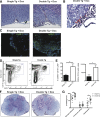Induced CNS expression of CXCL1 augments neurologic disease in a murine model of multiple sclerosis via enhanced neutrophil recruitment
- PMID: 29697856
- PMCID: PMC6033633
- DOI: 10.1002/eji.201747442
Induced CNS expression of CXCL1 augments neurologic disease in a murine model of multiple sclerosis via enhanced neutrophil recruitment
Abstract
Increasing evidence points to an important role for neutrophils in participating in the pathogenesis of the human demyelinating disease MS and the animal model EAE. Therefore, a better understanding of the signals controlling migration of neutrophils as well as evaluating the role of these cells in demyelination is important to define cellular components that contribute to disease in MS patients. In this study, we examined the functional role of the chemokine CXCL1 in contributing to neuroinflammation and demyelination in EAE. Using transgenic mice in which expression of CXCL1 is under the control of a tetracycline-inducible promoter active within glial fibrillary acidic protein-positive cells, we have shown that sustained CXCL1 expression within the CNS increased the severity of clinical and histologic disease that was independent of an increase in the frequency of encephalitogenic Th1 and Th17 cells. Rather, disease was associated with enhanced recruitment of CD11b+ Ly6G+ neutrophils into the spinal cord. Targeting neutrophils resulted in a reduction in demyelination arguing for a role for these cells in myelin damage. Collectively, these findings emphasize that CXCL1-mediated attraction of neutrophils into the CNS augments demyelination suggesting that this signaling pathway may offer new targets for therapeutic intervention.
Keywords: Autoimmunity; Chemokines; Demyelination; Neuroinflammation; Neutrophils.
© 2018 The Authors. European Journal of Immunology published by WILEY-VCH Verlag GmbH & Co. KGaA, Weinheim.
Figures





Similar articles
-
Inducible Expression of CXCL1 within the Central Nervous System Amplifies Viral-Induced Demyelination.J Immunol. 2016 Feb 15;196(4):1855-64. doi: 10.4049/jimmunol.1501802. Epub 2016 Jan 15. J Immunol. 2016. PMID: 26773148 Free PMC article.
-
Neutrophil-related factors as biomarkers in EAE and MS.J Exp Med. 2015 Jan 12;212(1):23-35. doi: 10.1084/jem.20141015. Epub 2015 Jan 5. J Exp Med. 2015. PMID: 25559893 Free PMC article.
-
An IFNγ/CXCL2 regulatory pathway determines lesion localization during EAE.J Neuroinflammation. 2018 Jul 16;15(1):208. doi: 10.1186/s12974-018-1237-y. J Neuroinflammation. 2018. PMID: 30012158 Free PMC article.
-
The contribution of neutrophils to CNS autoimmunity.Clin Immunol. 2018 Apr;189:23-28. doi: 10.1016/j.clim.2016.06.017. Epub 2016 Jul 1. Clin Immunol. 2018. PMID: 27377536 Free PMC article. Review.
-
The role of myelin oligodendrocyte glycoprotein in autoimmune demyelination: a target for multiple sclerosis therapy?Expert Opin Ther Targets. 2012 May;16(5):451-62. doi: 10.1517/14728222.2012.677438. Epub 2012 Apr 12. Expert Opin Ther Targets. 2012. PMID: 22494461 Review.
Cited by
-
The Role of Neutrophils in Multiple Sclerosis and Ischemic Stroke.Brain Sci. 2024 Apr 25;14(5):423. doi: 10.3390/brainsci14050423. Brain Sci. 2024. PMID: 38790402 Free PMC article. Review.
-
IL-10 and ICOS Differentially Regulate T Cell Responses in the Brain during Chronic Toxoplasma gondii Infection.J Immunol. 2019 Mar 15;202(6):1755-1766. doi: 10.4049/jimmunol.1801229. Epub 2019 Feb 4. J Immunol. 2019. PMID: 30718297 Free PMC article.
-
Testosterone Inhibits Secretion of the Pro-Inflammatory Chemokine CXCL1 from Astrocytes.Curr Issues Mol Biol. 2024 Mar 6;46(3):2105-2118. doi: 10.3390/cimb46030135. Curr Issues Mol Biol. 2024. PMID: 38534751 Free PMC article.
-
Sustained Infiltration of Neutrophils Into the CNS Results in Increased Demyelination in a Viral-Induced Model of Multiple Sclerosis.Front Immunol. 2022 Sep 29;13:931388. doi: 10.3389/fimmu.2022.931388. eCollection 2022. Front Immunol. 2022. PMID: 36248905 Free PMC article.
-
Neutrophils: Underestimated Players in the Pathogenesis of Multiple Sclerosis (MS).Int J Mol Sci. 2020 Jun 26;21(12):4558. doi: 10.3390/ijms21124558. Int J Mol Sci. 2020. PMID: 32604901 Free PMC article. Review.
References
-
- Baker, D. and Amor, S. , Experimental autoimmune encephalomyelitis is a good model of multiple sclerosis if used wisely. Mult. Scler. Relat. Disord. 2014. 3: 555–564. - PubMed
-
- Martin, R. , McFarland, H. F. and McFarlin, D. E. , Immunological aspects of demyelinating diseases. Annu. Rev. Immunol. 1992. 10: 153–187. - PubMed
-
- Rao, P. and Segal, B. M. , Experimental autoimmune encephalomyelitis. Methods Mol. Biol. 2012. 900: 363–380. - PubMed
-
- Zamvil, S. , Nelson, P. , Trotter, J. , Mitchell, D. , Knobler, R. , Fritz, R. and Steinman, L. , T‐cell clones specific for myelin basic protein induce chronic relapsing paralysis and demyelination. Nature 1985. 317: 355–358. - PubMed
Publication types
MeSH terms
Substances
Grants and funding
LinkOut - more resources
Full Text Sources
Other Literature Sources
Medical
Molecular Biology Databases
Research Materials

